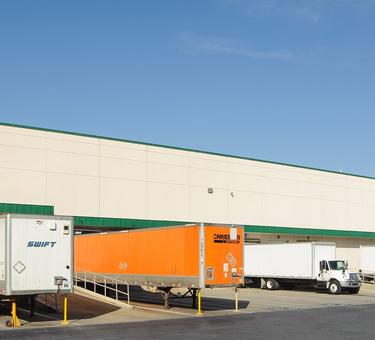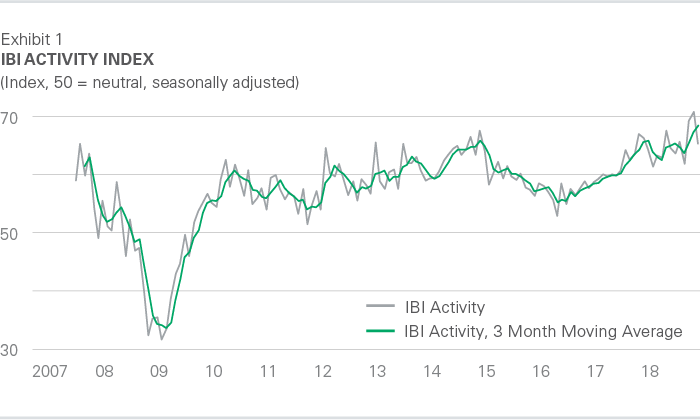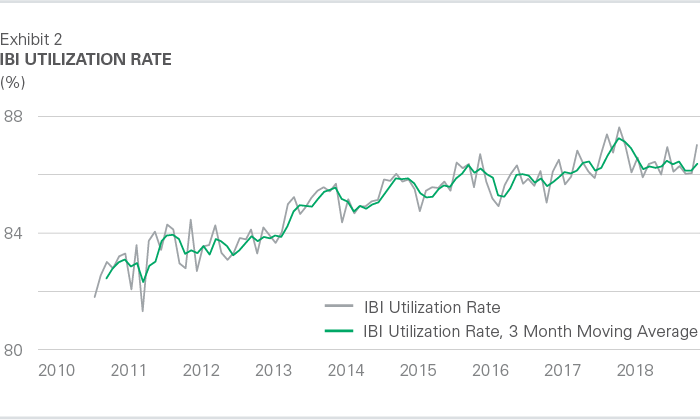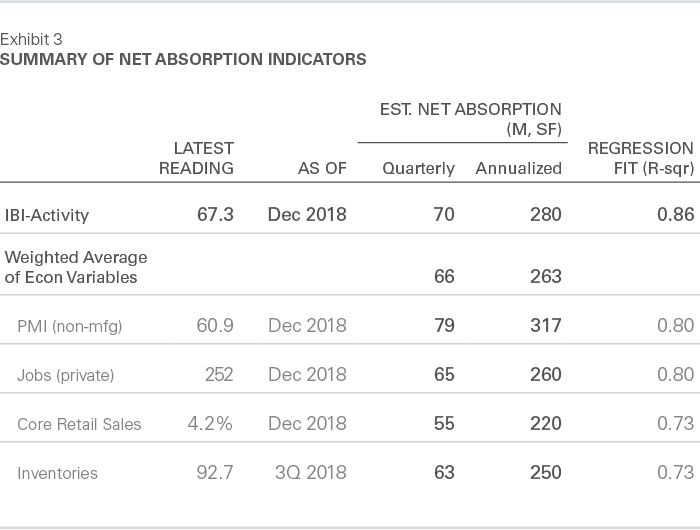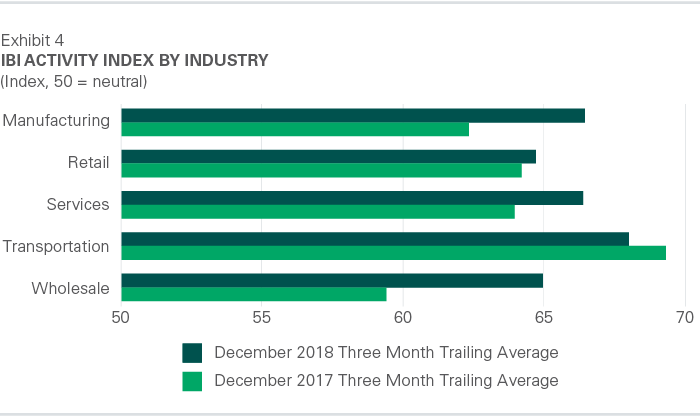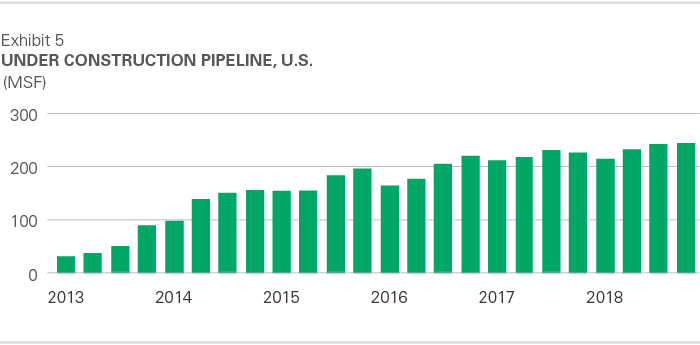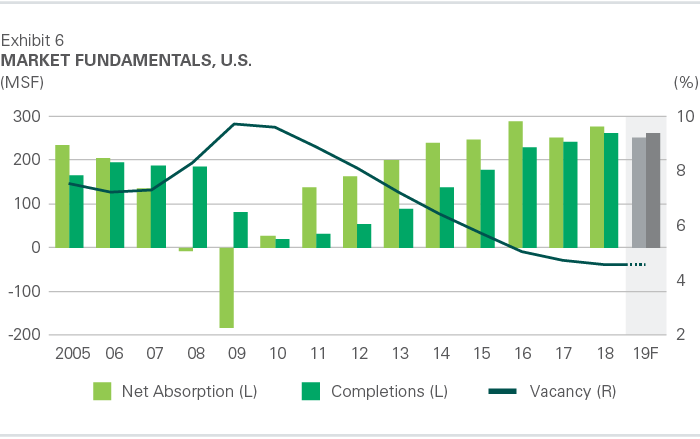
Logistics real estate users reported strong growth in activity and a peak utilization rate of 87% in U.S. logistics facilities during December 2018. The need for space was reflected in logistics market fundamentals, which posted demand in excess of new supply for the ninth consecutive year.1
Prologis Research expects that a slower pace of economic growth may lead to a slight decline in both completions and net absorption in 2019, relative to 2018’s elevated levels. Because these will move in tandem, we expect that the vacancy rate will remain steady at 4.5%, putting continued upward pressure on rental rates.
Activity in U.S. facilities and high utilization reveal that customers operating at capacity. Prologis’ proprietary Industrial Business Indicator (IBI)TM came in at 65.3 in December 2018, signaling strong growth (readings above 50 indicate growth). This reading was in line with the average for the year, but softened slightly from an average of 70.0 in November and October. At 87%, the utilization rate remained at near record levels in December. Utilization averaged 86.3% in 2018, even as logistics customers continued to rapidly expand their footprints.
Nearly all industries reported faster growth compared with last year. Among industries that we monitor, every industry except transportation reported a faster pace of activity growth in the fourth quarter relative to the same period in 2017. The activity reading was highest for transportation companies, at 68.0, and lowest for retailers at 64.7—still an elevated level.
Supply increased in 2018. Some 262 million square feet of logistics real estate came online in 2018, up 9% from 2017.2 Deliveries were primarily concentrated in outlying areas of large markets, which have low barriers to entry that allow developers to bring big-box product online. These markets included Dallas, Atlanta, the Inland Empire, Pennsylvania and Chicago. Outside of these few exceptions, supply remains in balance with demand. The pipeline of space under construction continued to expand gradually, reaching 246 million square feet in the fourth quarter of 2018, up about 8% year-over-year.3
Robust demand kept pace with higher completions. Stronger economic growth, the need to meet the ever-increasing demands of consumers, and a temporary push to boost inventory levels ahead of tariffs all coincided to drive logistics real estate demand. Net absorption totaled 276 million square feet in 2018, the second-highest total in a decade.4 A higher level of new supply coming online allowed for higher realized demand compared with 2017, when the market effectively hit capacity constraints.
The outlook is for another year of low vacancy and rising rents. Looking ahead to 2019, the combination of slower economic growth5 and a continued structural push to meet higher service level expectations (amplified by e-commerce) should offset each other, producing another year of roughly matched supply and demand. Prologis Research projects 250 million square feet of net absorption and 260 million square feet of deliveries in 2019. As a result, the vacancy rate should stabilize at its historic low of 4.5%, maintaining upward pressure on rental rates and making expansion challenging for customers in many markets.
Forward-Looking Statements
This material should not be construed as an offer to sell or the solicitation of an offer to buy any security. We are not soliciting any action based on this material. It is for the general information of customers of Prologis.
This report is based, in part, on public information that we consider reliable, but we do not represent that it is accurate or complete, and it should not be relied on as such. No representation is given with respect to the accuracy or completeness of the information herein. Opinions expressed are our current opinions as of the date appearing on this report only. Prologis disclaims any and all liability relating to this report, including, without limitation, any express or implied representations or warranties for statements or errors contained in, or omissions from, this report.
Any estimates, projections or predictions given in this report are intended to be forward looking statements. Although we believe that the expectations in such forward-looking statements are reasonable, we can give no assurance that any forward-looking statements will prove to be correct. Such estimates are subject to actual known and unknown risks, uncertainties and other factors that could cause actual results to differ materially from those projected. These forward-looking statements speak only as of the date of this report. We expressly disclaim any obligation or undertaking to update or revise any forward-looking statement contained herein to reflect any change in our expectations or any change in circumstances upon which such statement is based.
No part of this material may be (i) copied, photocopied, or duplicated in any form by any means or (ii) redistributed without the prior written consent of Prologis.
About Prologis Research
Prologis’ Research department studies fundamental and investment trends and Prologis’ customers’ needs to assist in identifying opportunities and avoiding risk across four continents. The team contributes to investment decisions and long-term strategic initiatives, in addition to publishing white papers and other research reports. Prologis publishes research on the market dynamics impacting Prologis’ customers’ businesses, including global supply chain issues and developments in the logistics and real estate industries. Prologis’ dedicated research team works collaboratively with all company departments to help guide Prologis’ market entry, expansion, acquisition and development strategies.
About Prologis
Prologis, Inc., is the global leader in logistics real estate with a focus on high-barrier, high-growth markets. As of December 31, 2018, the company owned or had investments in, on a wholly owned basis or through co-investment ventures, properties and development projects expected to total approximately 768 million square feet (71 million square meters) in 19 countries. Prologis leases modern logistics facilities to a diverse base of approximately 5,100 customers across two major categories: business-to-business and retail/online fulfillment.
Endnotes
- CBRE, JLL, Colliers, Cushman & Wakefield, CBRE-EA, Prologis Research
- CBRE, JLL, Colliers, Cushman & Wakefield, CBRE-EA, Prologis Research
- CBRE, JLL, Colliers, Cushman & Wakefield, CBRE-EA, Prologis Research
- CBRE, JLL, Colliers, Cushman & Wakefield, CBRE-EA, Prologis Research
- Consensus Economics, December 2018 report

